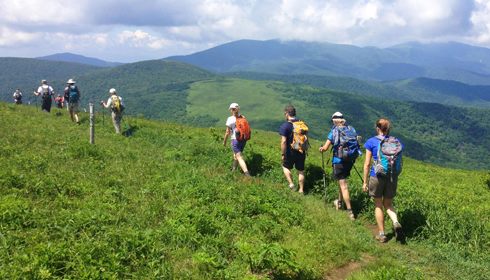Elk in the wild
Cataloochee Elk
By BRNN Treasurer Barbara Harrison
As you hike in the relatively remote Cataloochee valley in the Great Smokey Mountain National Park on a cool, crisp afternoon, you can hear the eerie sound of the bugling of the male elk. It is fall in the valley, and breeding season for the elks, known as the “rut”, is well under way. The Blue Ridge Naturalist Network spent a wonderful afternoon in the Cataloochee Valley in September learning about the re-introduction of these elk into the valley and their biology, with a wonderful opportunity to watch them.
Male elk, called bulls, make bugling calls to challenge other bulls and to attract female cows. One bull can have a harem of 8-10 cows. The cows will choose their mate and then join his harem based on the size of his antlers and on the tone and pitch of his bugle. Large bulls will use their antlers to intimidate and spar with other males and to dominate their harem. Each cow will give birth to only one calf in the spring after the rut in the previous fall.
In spring, the bulls lose their antlers. These large antlers are rich in calcium and phosphate and are quickly eaten by rodents and other animals. Their antlers grow back during the spring-summer months and will be full grown again by August. Elk are herbivores. They eat grasses, flowers, buds and leaves from shrubs and trees. They have excellent eye sight to protect them from predators.
Many years ago, elk roamed freely throughout the southern Appalachian Mountains, but by 1750 the elk were eliminated by over hunting and loss of habitat. In 2001, the effort began to reintroduce elk to the Great Smoky Mountains National Park. Initially, 25 elk were relocated from the Land Between the Lakes area along the Tennessee-Kentucky border. In 2002, 27 elk were relocated to the valley from Alberta, Canada. All 52 of these elk were released out into the Cataloochee valley. All of them wear collars for tracking and numbered ear tags for identification. Yellow ear tags are on the elk from the Land of the Lakes area. White ear tags are from the Canadian elk. and orange ear tags are on elk that have been born in the valley. If you see an elk with a lettered ear tag, it has been identified as a dangerous animal. Probably, this elk has been fed by humans and has lost its fear of humans and approaches them for food. Elk are large animals and cows with calves can be defensive. Bulls can also be defensive if humans approach their territory.
The Cataloochee valley is a wonderful place to observe these magnificent creatures. Keep your distance, however, at least 50 yards. Do not enter the fields where the elk are. Do not feed them. Let them live as they are meant to live and feel privileged to be able to see them in their natural habitat. They are truly a magnificent sight to see.
Directions: To get to the valley from interstate I-40, exit at North Carolina exit #20 and travel 0.2 miles on route 276. Turn right onto Cove Creek Road and follow the signs 11 miles into the Cataloochee Valley. To get there from Oconaluftee or Cherokee, take the Blue Ridge Parkway to Highway 19. Follow 19 (toward Asheville) through Maggie Valley. Turn left onto Highway 276 N. Just before the entrance ramp to I-40 (but past gas station), turn left and follow the signs 11 more miles to Cataloochee. Using the Cove Creek Road route, motorists will be traveling on a gravel road for approximately 15 minutes.






